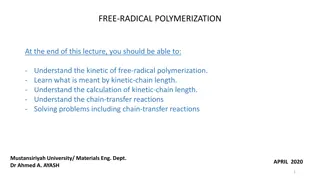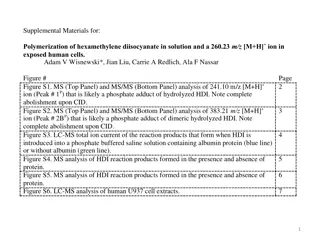Insights into Transition Metal Catalyzed Olefin Polymerization Mechanisms
Detailed exploration of transition metal catalyzed olefin polymerization via coordination-insertion mechanism, including the use of Ziegler-Natta catalysts, MAO activators, and stereochemical control of poly-1-alkenes. The mechanism, catalyst types, activators, and stereochemistry effects are discussed, shedding light on the synthesis of isotactic polymers.
Download Presentation

Please find below an Image/Link to download the presentation.
The content on the website is provided AS IS for your information and personal use only. It may not be sold, licensed, or shared on other websites without obtaining consent from the author.If you encounter any issues during the download, it is possible that the publisher has removed the file from their server.
You are allowed to download the files provided on this website for personal or commercial use, subject to the condition that they are used lawfully. All files are the property of their respective owners.
The content on the website is provided AS IS for your information and personal use only. It may not be sold, licensed, or shared on other websites without obtaining consent from the author.
E N D
Presentation Transcript
Transition Metal Catalyzed Olefin Polymerization via Coordination- Insertion Mechanism Yang Gao Engle Lab 13 September 2018
Ziegler-Natta Catalyst Named after Karl Ziegler and Giulio Natta Winners of the Nobel Prize (1963) Used to polymerize terminal alkenes Natta, G. et. al J. Am. Chem. Soc. 1955, 77, 1708.
Ziegler-Natta Catalyst Heterogeneous catalysts TiCl4 or TiCl3 supported on MgCl2 in presence of AlEt3 or AlEt2Cl Homogeneous metallocene catalysts Non-metallocene catalysts Application of methylaluminoxane (MAO) enhanced the activity by a factor of 10000
MAO Activators Examples of proposed MAO structures: Activation Mechanism: Large excess of MAO to Zr (102 to 104 : 1) is needed. Marks, T. et. al. Chem. Rev. 2000, 100, 1391
Mechanism of Ziegler-Natta Polymerization Grubbs, R. H. Acc. Chem. Res.1996, 29, 85 Evidence of -agnostic interaction: Brintzinger, H. H. Angew. Chem. Int. Ed. Engl. 1990, 102, 1412
Stereochemistry of poly-1-alkenes 13C NMR (Me region) Isotactic PP ([mmmm] > 90%) ???(????) SUM [??? ?????? ] [????] = m (meso), r (racemo) atactic PP The 13C shift of CH3 is determined by the configurations of two neighboring units Brintzinger, H-H. Angew. Chem. Int. Ed. Engl. 1995, 34, 1143
Stereochemical Control General symmetry classification: [mmmr]:[mmrm] = 1:1 [mmmr]:[mmrm]:[mrrm] = 2:2:1 Coates, G. W. Chem. Rev. 2000, 100, 1223
C2-Symmetric Catalysts for Isotactic Polymers Brintzinger, H-H. Angew. Chem. Int. Ed. Engl. 1985, 24, 507 The most successful catalysts are those with rigid C2-symmetric chelating ligands with a bridging group. Coates, G. W. Chem. Rev. 2000, 100, 1223
Syndiotactic-PP Synthesis Ewen, O., J. Am. Chem. Soc. 1988, 110, 6255. entry catalyst activity [rrrr] [mmmm] 1 34 2160 83.7 0.0 2 35 1750 98.9 0.0 3 36 1730 95.9 0.0 4 37 722 90.5 0.0 5 38 930 41.8 5.6 Bercaw, J. E. J. Am. Chem. Soc, 1996, 118, 11988
Mechanism for Ligand Controlled Polymerization C2-symmetric catalyst isotactic Homotopic reaction site, -agostic interaction enhanced selectivity Cs-symmetric catalyst syndiotactic Enantiotopic reaction site Coates, G. W. Chem. Rev. 2000, 100, 1223
Early Development of Late-TM Catalyzed Polymerization SHOP-type catalysts (SHOP = Shell Higher Olefin Process) Evaluation of Late-metal system: Facile ability to undergo -hydride elimination Ligand design Low activity towards olefin insertion because of the rich- electron d orbitals Electrophilicity tuning Good functional group tolerance
-Diimine System The electrophilic and cationic metal centers Sterically bulky bidentate ligands Bulky non-coordinating counterions Ligand displacement methods: Cationic complexes synthesis: Brookhart, M. Chem. Rev. 2000, 100, 1169
-Diimine Mediated Ethylene Polymerization Pd catalyst Highly branched PE without the intermediacy of -olefin Useful as base stocks or additives for lubricants Turnover-limiting step: migration insertion Barrier (insertion) in the Ni complex is ca. 4-5 kcal/mol lower than the Pd complex. Increased steric bulk of ligand promotes insertion reaction. Brookhart, M. Chem. Rev. 2000, 100, 1169
Ethylene/Methyl Acrylate(E/MA) Copolymerization Brookhart, M. Chem. Rev. 2000, 100, 1169 amorphous, highly branched, ester groups located at the end of branches mostly Large MA/E ratio needed Other successful examples: methyl vinyl ketones and sillyl vinyl ethers Failed case: vinyl acetate, acrylonitrile and vinyl chloride
Phosphine-Sulfonate Ligand synthesis: Ethylene Polymerization: Bulky substituents on the phosphorus atom helps! Ethylene insertion: -H elimination (suppressed with high [C2H4]: Nozaki, K. Chem. Rev. 2009, 109, 5215
E/PVM Copolymerization with P-S System Nozaki, K. J. Am.Chem. Soc. 2009, 131, 14606 Nozaki, K. J. Am.Chem. Soc. 2007, 129, 8948 Jordan, R. F. J. Am.Chem. Soc. 2007, 129, 8946 Jordan, R. F. J. Am.Chem. Soc. 2007, 129, 15450 R1 = Me R2 = NMe2 R3 = 2,4-(MeO)2C6H3 Carrow, B. P. J. Am.Chem. Soc. 2018, 140, 8841
A New Family of E/PVM Copolymerization Catalysts Bisphosphine Monoxide Pd Complexes Nozaki, K. J. Am. Chem. Soc. 2012, 134, 8802























